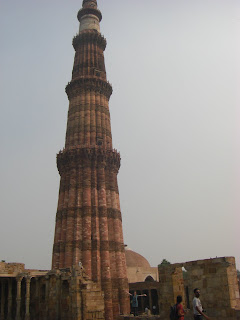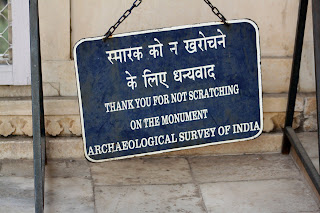Not all of those hanging out at the historical, World Heritage sights were human.
There was a wide range of other visitors.
 A monkey brought her baby to see the Taj Mahal.
A monkey brought her baby to see the Taj Mahal.
 A dog was exploring along the wall of the Agra fort palace.
A dog was exploring along the wall of the Agra fort palace.
 The monkeys also thought the fort was a good place to hang out,
The monkeys also thought the fort was a good place to hang out,
 and to see some of the other tourists.
and to see some of the other tourists.
The parrots liked the artistic carvings around the Qutab Minar.

 And the pigeons were checking out the keystone-less arches.
And the pigeons were checking out the keystone-less arches.

At Fatehpur Sikri, there was a chipmunk who stopped for a snack.
Word is out that sightseeing is a good past time.
There was a wide range of other visitors.
 A monkey brought her baby to see the Taj Mahal.
A monkey brought her baby to see the Taj Mahal. A dog was exploring along the wall of the Agra fort palace.
A dog was exploring along the wall of the Agra fort palace. The monkeys also thought the fort was a good place to hang out,
The monkeys also thought the fort was a good place to hang out, and to see some of the other tourists.
and to see some of the other tourists.The parrots liked the artistic carvings around the Qutab Minar.

 And the pigeons were checking out the keystone-less arches.
And the pigeons were checking out the keystone-less arches.
At Fatehpur Sikri, there was a chipmunk who stopped for a snack.
Word is out that sightseeing is a good past time.












































